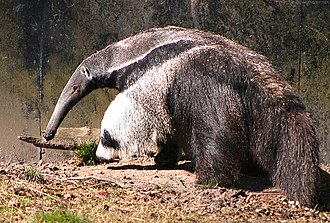- Anteaters are medium-sized mammals known for their long snouts and tongues.
- They are native to Central and South America, primarily found in tropical forests and grasslands.
- There are four species of anteaters: the giant anteater, silky anteater, northern tamandua, and southern tamandua.
- Anteaters are primarily insectivores, feeding mainly on ants and termites.
- They have a specialized tongue that can extend up to two feet (60 cm) in length to reach deep into ant and termite nests.
- Anteaters have sharp, curved claws on their front feet that they use to tear open ant mounds and termite nests.
- Despite their name, anteaters do not actually eat ants or termites exclusively; they also consume other insects, such as beetles and larvae.
- They have no teeth and swallow their prey whole, relying on muscular stomachs to grind the insects.
- Anteaters have a low metabolic rate and move slowly, conserving energy in their relatively sedentary lifestyle.
- They are solitary animals, typically only coming together for mating purposes.
- Anteaters have a keen sense of smell that helps them locate ant and termite colonies.
- They have a strong sense of hearing and can detect the sounds of insects within their nests.
- Anteaters have a thick, bushy tail that provides balance and support when climbing trees.
- They have long, sharp claws on their hind feet, which they use for defense against predators.
- Anteaters are excellent climbers and can use their strong claws to scale trees in search of prey.
- They have a protective coating of long, coarse fur that helps shield them from insect bites.
- Anteaters have a distinctive appearance, with elongated snouts, small eyes, and large, rounded ears.
- They are typically solitary animals, with males and females coming together only during the breeding season.
- Anteaters communicate using vocalizations such as grunts, hisses, and snorts.
- They have poor eyesight but make up for it with their exceptional sense of smell and hearing.
- Anteaters are excellent swimmers and can cross rivers and streams when necessary.
- They have a specialized digestive system that allows them to break down and extract nutrients from their insect prey.
- Anteaters are preyed upon by larger predators such as jaguars, pumas, and large birds of prey.
- They have sharp, powerful front claws that are used for digging into ant and termite mounds.
- Anteaters have a gestation period of about 190 days, after which a single offspring is born.
- Baby anteaters, called pups, ride on their mother’s back for several months until they are capable of finding food on their own.
- Anteaters have a unique walking style, shuffling on their knuckles to protect their long claws.
- They are protected by a thick layer of sticky saliva on their tongues that traps insects as they feed.
- Anteaters have a strong sense of territory and mark their boundaries with scent markings.
- They are known for their defensive behavior of standing on their hind legs and using their forelimbs and tail for balance.
- Anteaters have a long lifespan in captivity, with some individuals living up to 20 years.
- They are known to have a strong immunity to ant and termite bites due to their thick skin.
- Anteaters are important in maintaining ecological balance by controlling insect populations.
- They are well-adapted to their environment, with their specialized snouts and tongues perfectly suited for their insectivorous diet.
- Anteaters have been featured in popular culture, appearing in books, cartoons, and as mascots for sports teams.
- They are often associated with tropical ecosystems and are considered flagship species for conservation efforts.
- Anteaters have long been admired for their unique feeding adaptations and fascinating behavior.
- They have a large range of vocalizations, including snorts, growls, and hisses, which they use for communication and defense.
- Anteaters are surprisingly agile climbers and can navigate tree branches with ease.
- They have a distinct sense of territory and will defend their feeding areas from other anteaters.
- Anteaters have a high metabolic rate, allowing them to digest and process their insect diet efficiently.
- They have a long, sticky tongue that can flick in and out of their mouth up to 160 times per minute.
- Anteaters have been known to travel long distances in search of food, using their keen sense of smell to locate ant and termite colonies.
- They are known for their unique reproductive behavior, with males engaging in elaborate courtship rituals to attract females.
- Anteaters have a remarkable sense of touch, allowing them to detect movement and vibrations in the ground to locate their prey.
- They have excellent camouflage, with their fur often resembling the bark of trees, making them difficult to spot in their natural habitat.
- Anteaters play a crucial role in ecosystem balance by controlling insect populations, which helps maintain the health of the ecosystem.
- They have been studied extensively by scientists to understand their feeding adaptations and their ecological impact.
- Anteaters have a diverse range of species, each with its own unique characteristics and adaptations.
- They are fascinating creatures that captivate the interest and curiosity of researchers and nature enthusiasts, with their specialized feeding habits and enigmatic behavior.
Facebook Comments


































